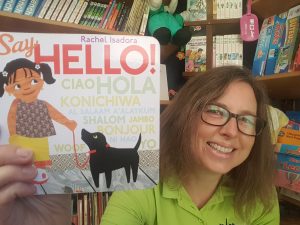
I cannot quite remember how I came across this lovely short story but am glad I did!
Click here to watch a short video of me showing you inside the book and introducing it to you!
Language of text: mostly English, with greetings in various languages
Type of text: picture book
Author or source: Rachel Isadora, published by Penguin
Intended age of students: Key Stage 1/2/3
Source reference: 9780399256325
Approaches:
This is the story of a little girl, Carmelita, and all the people in her neighbourhood: how she greets them all in their own language on her way to visit her grandma.
The book can be used in class or as part of a whole school assembly.
After reading the story throughout and asking the children what they think it is about, you can do one or more of the following activities.
1. Can you work out (and write on a white board) what language is spoken on each double-page?
2. Repeat the greetings after the teacher; the teacher reads the story again but stops at each greeting and the children have to say it; after practising, the teacher says a greeting, the children have to say which language it is in; finally the teacher says a language, the children say the greeting (played in teams).
3. Discuss the culture associated with each language; look carefully at the illustrations for clues.
4. Each child could choose a greeting, look up a country where that language is spoken and make a poster with the flag next to the country and the language; or as a class they could research all the languages and draw something for each greeting.
5. What does how we say each greeting tell you about how to speak that language? eg c+i in Italian make a “ch” sound.
Rationale:
This story is written in English, apart from the “hellos” in 9 other languages. Those can be found at the end, in alphabetical order: it indicates how to pronounce the different greetings and tells you what language they are in, so you do not need to know them all.
As a result, it that can be used with children of all ages.
Outcomes:
The children will gain an awareness and acceptance of the languages around them; they will enjoy practising different greetings, looking at different spellings and making different sounds. They will also reflect on other cultures.
Topics or themes:
raising awareness of other languages used around us; special languages days
How much time required:
1 lesson
Buy the story at Little Linguist by clicking here.
As I was looking for more information about the book, I came across this document by UNICEF: click here for some inspiring ideas for assemblies!
If you are looking for more activities that relate to the European Day of Languages, click here.
I have selected here more stories which are perfect for languages days.
What is YOUR favourite story in English which talks about other languages? Do tell me in the comments below, I would love to know! Merci !
Nathalie
